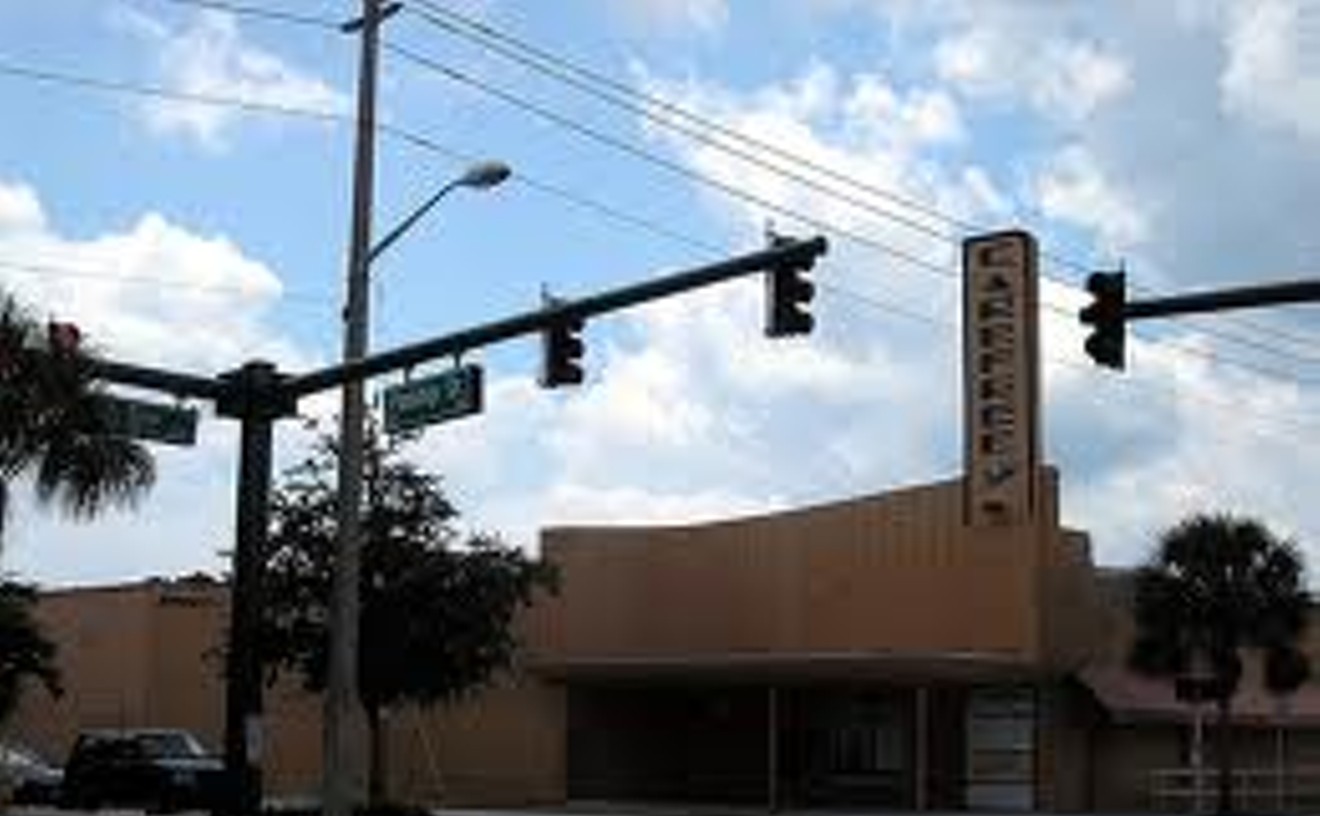Best Film Festival
Fort Lauderdale International Film Festival
After 14 years this sprawling event is still pretty much the only game in town. Its days as a scrappy little upstart are long gone, replaced by an ambitious schedule that screens more than a hundred flicks from all over the world over the course of three and a half weeks. Sometimes it seems as if executive director Gregory von Hausch wants the festival to be all things to all people, but he also continues to have shrewd instincts. Year before last he gave Affliction and Little Voice exposure long before they snagged their Oscar nominations, and for the most recent festival he did the same with Pedro Almodóvar's now-acclaimed All About My Mother, which went on to win an Oscar, and Tumbleweeds, which didn't. He also unearthed such still-overlooked gems as Joe the King and The War Zone and brought gay icon Bruce Vilanch to the masses with the riotous documentary Get Bruce!
Best Film Festival
Fort Lauderdale International Film Festival
After 14 years this sprawling event is still pretty much the only game in town. Its days as a scrappy little upstart are long gone, replaced by an ambitious schedule that screens more than a hundred flicks from all over the world over the course of three and a half weeks. Sometimes it seems as if executive director Gregory von Hausch wants the festival to be all things to all people, but he also continues to have shrewd instincts. Year before last he gave Affliction and Little Voice exposure long before they snagged their Oscar nominations, and for the most recent festival he did the same with Pedro Almodóvar's now-acclaimed All About My Mother, which went on to win an Oscar, and Tumbleweeds, which didn't. He also unearthed such still-overlooked gems as Joe the King and The War Zone and brought gay icon Bruce Vilanch to the masses with the riotous documentary Get Bruce!
Best Art Gallery
Haitian Art Collection
Long before Haitian art became fashionable -- a dozen years ago, to be exact -- gallery owner Katie Barr was struggling to make her mark in the competitive South Florida art market. She started out with a tiny space in a nondescript little shopping plaza in Boca Raton, where she attracted potential customers with cheese-and-wine receptions and began building up a selection of world-class art from the tiny island nation's disproportionate population of artists. Three years ago she moved her shop to a slightly larger space a few feet away from bustling Atlantic Avenue in downtown Delray Beach. Her business boomed, but her mission remains the same: sharing her knowledge and enthusiasm for some of the most exuberant art in the world, which she stocks in all its amazing variety, from paintings on canvas and board to metal sculptures to beaded vodou flags to decorative furniture and more.
Best Art Gallery
Haitian Art Collection
Long before Haitian art became fashionable -- a dozen years ago, to be exact -- gallery owner Katie Barr was struggling to make her mark in the competitive South Florida art market. She started out with a tiny space in a nondescript little shopping plaza in Boca Raton, where she attracted potential customers with cheese-and-wine receptions and began building up a selection of world-class art from the tiny island nation's disproportionate population of artists. Three years ago she moved her shop to a slightly larger space a few feet away from bustling Atlantic Avenue in downtown Delray Beach. Her business boomed, but her mission remains the same: sharing her knowledge and enthusiasm for some of the most exuberant art in the world, which she stocks in all its amazing variety, from paintings on canvas and board to metal sculptures to beaded vodou flags to decorative furniture and more.
Best New Play
A Bicycle Country
Nilo Cruz's haunting A Bicycle Country, a play about three Cuban balseros, arrived at the Florida Stage just a few weeks after rafter Elián Gonzalez was rescued off nearby Palm Beach. Here's betting it will be remembered long after young Elián grows up. Set in Cuba and in the waters between Havana and Miami, the play stakes a claim in the dramatic territory of Samuel Beckett, with its evocative language, startling visual imagery, and existential concerns. Cruz's portrayal of the trio who escape from Cuba is both literal and metaphorical. Indeed, less a political play than a statement about yearning, A Bicycle Country is capable of transcending the narrow politics of 1999 and 2000 and becoming a work that can shed light on any group of desperate people. Which is exactly what great art is supposed to do.
Best New Play
A Bicycle Country
Nilo Cruz's haunting A Bicycle Country, a play about three Cuban balseros, arrived at the Florida Stage just a few weeks after rafter Elián Gonzalez was rescued off nearby Palm Beach. Here's betting it will be remembered long after young Elián grows up. Set in Cuba and in the waters between Havana and Miami, the play stakes a claim in the dramatic territory of Samuel Beckett, with its evocative language, startling visual imagery, and existential concerns. Cruz's portrayal of the trio who escape from Cuba is both literal and metaphorical. Indeed, less a political play than a statement about yearning, A Bicycle Country is capable of transcending the narrow politics of 1999 and 2000 and becoming a work that can shed light on any group of desperate people. Which is exactly what great art is supposed to do.
Best Production of a Play
Quills
In many American political plays, a guy (it's usually a guy) comes on stage and talks. The set, the costumes, the lighting -- they're all window-dressing, which helps to explain the sorry state of political drama. Doug Wright's 1995 work Quills, however, dissects the issues of censorship through the trials of the Marquis de Sade. It's a play of ideas, driving home the notion that you can't get rid of art you don't like merely by destroying its author. But it's also a play of images. In the exquisitely designed Florida Stage production, Jim Fulton's lighting design reproduced the Marquis' naughty writing as luminescent streaks across the theater walls. Allen D. Cornell's inventive turntable set gave rise to multiple arresting scenes -- not the least of which was the yanking out of the Marquis' tongue. Suzette Pare's costumes smartly outfitted the small-minded denizens of 19th-century France as well as the increasingly-more-disrobed Marquis. And Scott Burgess' sound design created an asylumwide orgy we could "see" though it happened off stage. At the helm was artistic director Louis Tyrrell, whose fluid hand and wicked sense of humor proved to be assets the Marquis would have loved.
Best Production of a Play
Quills
In many American political plays, a guy (it's usually a guy) comes on stage and talks. The set, the costumes, the lighting -- they're all window-dressing, which helps to explain the sorry state of political drama. Doug Wright's 1995 work Quills, however, dissects the issues of censorship through the trials of the Marquis de Sade. It's a play of ideas, driving home the notion that you can't get rid of art you don't like merely by destroying its author. But it's also a play of images. In the exquisitely designed Florida Stage production, Jim Fulton's lighting design reproduced the Marquis' naughty writing as luminescent streaks across the theater walls. Allen D. Cornell's inventive turntable set gave rise to multiple arresting scenes -- not the least of which was the yanking out of the Marquis' tongue. Suzette Pare's costumes smartly outfitted the small-minded denizens of 19th-century France as well as the increasingly-more-disrobed Marquis. And Scott Burgess' sound design created an asylumwide orgy we could "see" though it happened off stage. At the helm was artistic director Louis Tyrrell, whose fluid hand and wicked sense of humor proved to be assets the Marquis would have loved.
Best Movie Theater
Carefree Theatre

The Carefree Theatre is about as ugly as you can get in a movie theater: The seats are bereft of stuffing, the one screen is annoyingly old school, and the floor is, well, let's just say you wouldn't want to sit on it. But in a place about as arty as a late-night B-movie Baywatch rip-off, we're willing to forgive the lack of pretentiousness. Besides, we've caught some great oddball flicks at the Carefree in the last year: Boys Don't Cry (before it became a multiplex sensation after Hillary Swank took home an Oscar), Twin Falls Idaho, and Eric Rohmer's Conte d'Automne (that's Autumn Tale for you non-art-moviegoers), to name just a few. Not to mention the irreverent, occasionally brilliant, one-night-only FLO Film Festival, which featured a hilarious short film about a dude having his girlfriend's name tattooed on his penis. (See if you can find that at your local gigabyteplex.) Oh yeah. The Carefree also does The Rocky Horror Picture Show every Saturday at midnight. That is so, um, arty.
- 2000 S. Dixie Highway, West Palm Beach, 33401 Map
- 561-833-7305
Best Movie Theater
Carefree Theatre
The Carefree Theatre is about as ugly as you can get in a movie theater: The seats are bereft of stuffing, the one screen is annoyingly old school, and the floor is, well, let's just say you wouldn't want to sit on it. But in a place about as arty as a late-night B-movie Baywatch rip-off, we're willing to forgive the lack of pretentiousness. Besides, we've caught some great oddball flicks at the Carefree in the last year: Boys Don't Cry (before it became a multiplex sensation after Hillary Swank took home an Oscar), Twin Falls Idaho, and Eric Rohmer's Conte d'Automne (that's Autumn Tale for you non-art-moviegoers), to name just a few. Not to mention the irreverent, occasionally brilliant, one-night-only FLO Film Festival, which featured a hilarious short film about a dude having his girlfriend's name tattooed on his penis. (See if you can find that at your local gigabyteplex.) Oh yeah. The Carefree also does The Rocky Horror Picture Show every Saturday at midnight. That is so, um, arty.





